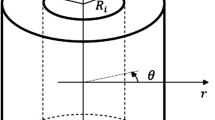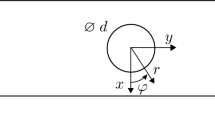Abstract
Holes in engineering structures cause stress concentrations that often lead to failure. In nature, however, blood vessel holes (foramina) in load-bearing bones are not normally involved in structural failures. It has been found that this behavior is linked to the material distribution near the hole. In the present paper, we have investigated the effectiveness of optimizing the radial distribution of the isotropic elastic modulus around a circular hole to increase load-carrying capacity. Bezier curves were used to describe the radial distribution of the elastic modulus. Since changing the elastic modulus usually affects the strength, the ratio of maximum principal stress to strength was chosen as the objective function for optimization. Using non-dimensional analysis of the 2-D elasticity equations, we identified three parameters that govern the optimum design and are applicable to a wide range of materials, loading, and geometries. The first is a material parameter that describes the relationship between the strength and elastic modulus, the second is the geometric parameter given by the ratio of the optimized field to the hole radius, and the third is the biaxial load ratio. The effect of failure criterion choice on the optimum elastic modulus distribution is also investigated. Optimum elastic modulus distributions for materials whose strength increases faster than the stiffness, as density and/or composition is varied, completely eliminated the effect of the hole by locally stiffening areas that experience high stresses. When the strength lagged behind the stiffness, optimum designs were similar to those found in bones, and relied on modulus distributions that direct the loads away from the hole.
Similar content being viewed by others
References
Engels, S.; Becker, W. 2000: Optimization of hole reinforcements by doublers. Struct. Multidisc. Optim. 20, 57–66
Gibson, L.J.; Ashby, M. F. 1997: Cellular solids: structure and properties, 2nd edn. Cambridge: Cambridge University Press
Götzen, N.; Cross, A.R.; Ifju, P.G.; Rapoff, A.J. 2003: Understanding stress concentration around a nutrient foramen. J. Biomech.; to appear in 2003 available online (in press)
Haftka, R.T.; Starnes, J. 1988: Stiffness tailoring for improved compressive strength of composite plates with holes. AIAA J. 26, 72–77
Heller, M.; Kaye, R.; Rose, L.R.F. 1999: Gradientless finite element procedure for shape optimization. J. Strain Anal. Eng. Des. 34, 323–336
Huang, J. 2000: Heterogeneous component modeling and optimal design for manufacturing. Ph.D. Dissertation, Department of Mechanical Engineering, Clemson University
Huang, J.; Fadel, G. 2000: Heterogeneous flywheel modeling and optimization. J. Mater. Des. (special issue for Rapid Prototyping), 112–125
Hyer, M.W.; Charette, R.F. 1991: Use of curvilinear fiber format in composite structure design. AIAA J. 29, 1011–1015
Martin, R.B. 1991: Determinants of the mechanical properties of bones. J. Biomech. 24, 79–88
Parvizian, J.; Fenner, R.T. 1997: On shape optimization by the boundary element method using normal growth approach. In: Collection of Technical Papers – AIAA/ASME/ASCE/AHS/ASC Structures, Structural Dynamics & Materials Conference (held in New York). AIAA J. 2, 1397–1403
Rajaiah, K.; Naik, N.K. 1984: Hole-shape optimization in a finite plate in the presence of auxiliary holes. Exp. Mech. 24, 157–161
Sasaki, T.; Sekine, H.; Fukunaga, H. 1996: Optimal relaxation of stress concentrations in adaptive plates with holes using piezoelectric actuators. A Hen/Trans. Jpn. Soc. Mech. Eng., Part A 62, 458–465
Savin, G.N. 1961: Stress concentration around holes, 234–301. New York: Pergamon Press
Sensharma, P.K.; Haftka, R.T. 1996: Limits of stress reduction in a plate with a hole using piezoelectric actuators. J. Intell. Mater. Syst. Struct. 7, 363–371
Tran, D.; Nguyen, V. 1999: Optimal hole profile in a finite plate under uniaxial stress by finite element simulation of Durelli’s photoelastic stress minimization method. Finite Elem. Anal. Des. 32, 1–20
Vanderplaats, Miura & Associates, 1993: DOT users manual
Venkataraman, S.; Haftka, R.T.; Rapoff, A.J. 2003: Structural optimization using biological variables to understand how bones design holes. Struct. Multidisc. Optim. 25, 19–34
Venter, G. 1998: Non-dimensional response surfaces for structural optimization with uncertainty. Ph.D. Dissertation, Department of Aerospace Engineering, Mechanics & Engineering Science, University of Florida
Wall, M.: GAlib: A C++ Library of Genetic Algorithm Components, version 2.4.5. Freeware available at http://lancet.mit.edu/ga/ (accessed on Dec 11, 2001)
Young, W.C. 1989: Roark’s formulas for stress & strain. New York: McGraw-Hill
Author information
Authors and Affiliations
Corresponding author
Rights and permissions
About this article
Cite this article
Huang , J., Venkataraman , S., Rapoff , A. et al. Optimization of axisymmetric elastic modulus distributions around a hole for increased strength. Struct Multidisc Optim 25, 225–236 (2003). https://doi.org/10.1007/s00158-003-0293-8
Received:
Revised:
Published:
Issue Date:
DOI: https://doi.org/10.1007/s00158-003-0293-8




